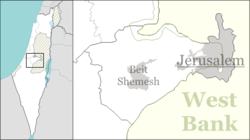Neve Michael
| Neve Michael | |
|---|---|

Neve Michael as viewed from the Elah Valley
|
|
| Coordinates: 31°40′24.6″N 35°0′27.35″E / 31.673500°N 35.0075972°ECoordinates: 31°40′24.6″N 35°0′27.35″E / 31.673500°N 35.0075972°E | |
| District | Jerusalem |
| Council | Mateh Yehuda |
| Affiliation | Hitahdut HaIkarim |
| Founded | 1958 |
| Founded by | Persian Jews |
| Population (2015) | 630 |
Neve Michael (Hebrew: נְוֵה מִיכָאֵל, lit. Michael's Haven) is a moshav in central Israel. Located in the Adullam region and built upon an eminence in the far south-east end of the Elah Valley, close to where the historic fight between David and Goliath took place, it falls under the jurisdiction of Mateh Yehuda Regional Council. In 2015 it had a population of 630.
The village was established on 29 July 1958 (12 Av 5718 anno mundi) by Kurdish immigrants from Iran on farm land that had belonged to the depopulated Arab village of Bayt Nattif. The place had formerly been known as Khirbet Jurfah. The newly restructured Jewish National Fund, working in concert with Hitahdut HaIkarim, settled new immigrants on the site in 1958, giving to the place the name Roglit (Hebrew: רוֹגְלִית), meaning "tiller [of the grapevine]". A newer regional community center built alongside it was given the name Neve Michael, in memory of American philanthropist, Michael M. Weiss, who was a donor to the Jewish National Fund.
The newer section had a regional elementary school which catered to children from the surrounding communities of Roglit, Aderet and Aviezer, but closed its doors in 1968. Today, the grounds of the old school serve as a home for the mentally retarded. When the new settlement of Neve Michael failed to attract new residents, the settlement of Neve Michael was merged with Roglit in 1983. A new Israel Border Police outpost was also built in Neve Michael, which was later abandoned after the Six-Day War, following the change in demarcation lines. The founders were joined by immigrants from North Africa, mainly Morocco. In 2005 the village started an expansion plan attracting many younger families to the moshav. The moshav has a mixed population with people of different, ages, ethnic background and Jewish religious observance.
...
Wikipedia

